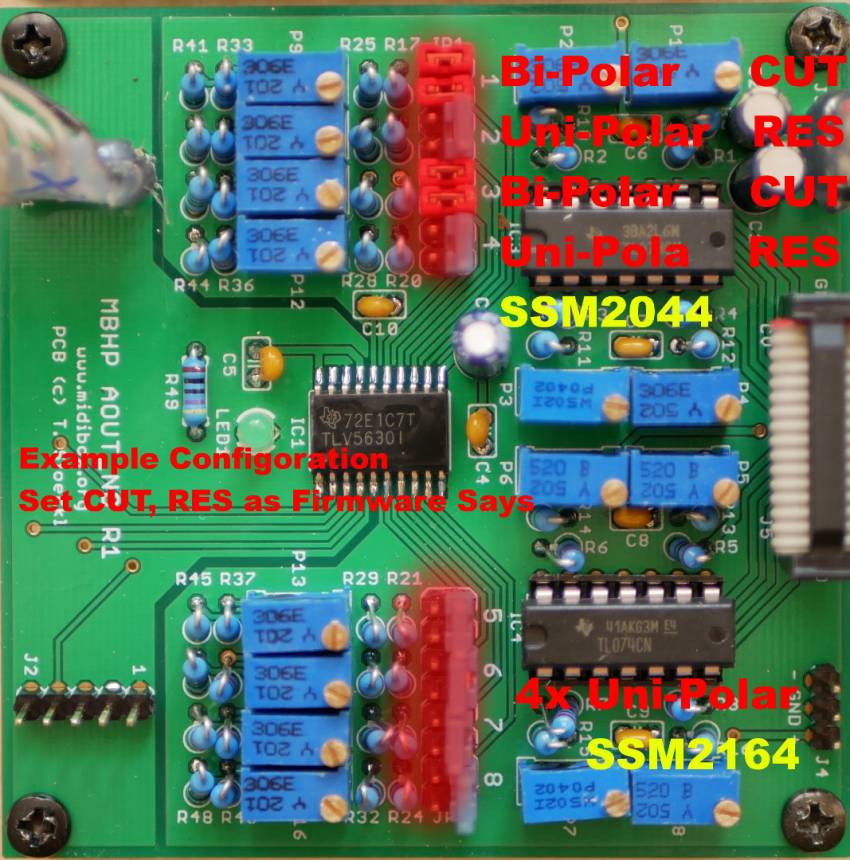This is an old revision of the document!
Table of Contents
ssm2164_seppoman pcb - getting started - how to setup
the following informations are take from the midibox forum, its a collection of infos, without the claim to be 100% true, i will try to test the given information.
Power
+ GND -
J5 is obviously the only connector where you could come to the conclusion that it might have something to do with power supply.Just like the:
AOUT(NG), the 2044 board, the MB_FM module etc, it expects a bipolar power supply of +/- 12 V and GND.
CV
as a general rule of thumb you can assume that everything that doesn't specifically mention a bipolar control voltage will expect an unipolar CV.
In the case of this module, IIRC the dynamic range of the regular CV range (0 .. 11.67V) (uni-polar!) is about 65 dB, with 0V being “silence” and 11.67V being unity gain.
I have never thought about what happens if you apply a negative voltage to the CV input…
Note also that generally a bipolar control voltage (CV) still doesn't mean that there are more than two wires involved,
just the one signal can be above or below GND.
AOUT_NG Connect and Setup
AOUT_NG Stuffing Parts PCB
Resistor Solution stock - very low voltage
if you followed aout_ng built plan you will get following Stock-CV-Voltages @+-12V PSU:
Uni-Polar CV-Range: 0-11,4V
Bi-Polar CV-Range: +-3V
SSM2164 & Stock AOUT_NG:
As the SSM2164 is UniPolar, and seppoman designed it as a couple with AOUT_NG. stock is ok
SSM2044 & Stock AOUT_NG:
As the CUT-Off-CV is UniPolar, and seppoman designed it as a couple with AOUT_NG. stock is ok
I guess for proper +/- 5V operation I'll have to try out a few other resistor values on the SSM module,
but this will only apply if you if you're using a different CV source than an AOUT_NG.\\
If you need more CV-Range:
for more distortion, drive, range, or other modules:
if you sum two voltages through two resistors of same value, you'll get (V1+V2) / 2 as a result…
Resistor Solution low voltage - seppomans prefered
R9…R16 > 5.6k (only on the channels that are setup for bipolar mode)
+-3.5V to +-5.8V Bi-Polar calibration range
Pro: easy job, still have a decent precision when calibrating.
Resistor Solution Stock - NorthernLightX prefered
we came to the conclusion that it's probably much easier to have the AOUT only output unipolar 0 to 10 volt, and design a simple -5v level shifter board that can be used as an add-on (or separate module with hands-on access to the level shifting) to shift the output to -5 to +5 volt where needed.
Things to consider are:
- not a lot of equipment actually makes use of negative voltages
- equipment that needs bipolar CV input can be retrofitted with a fixed level shifter at the input to make it compatible with your other modules
- negative voltages can be used for CV modulation purposes (modulate one CV source with another) so it's certainly not useless
Resistor Solution high voltage
R1…R8 > 10k
R9…R16 >2.2k (on all channels). (QUESTION WHY ON ALL? 
+9.5V to +22V Uni-Polar calibration-range
+-2.4V to +-5.5V Bi-Polar calibration-range ( dont think so 
Pro: preserve the “just change the jumpers if you need some channel in bipolar mode” thought behind this option.
Con:dramatically increase the calibration range, i.e. exactly calibrating the outputs will get harder because the same angle of turning the pot will have much more impact.

